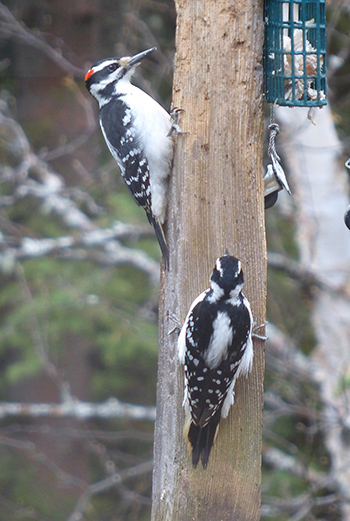Revealing the Tricks of Woodpeckers: Actions, Environment, and More
Woodpeckers, with their distinct actions and specialized adaptations, have actually long attracted researchers and nature enthusiasts alike. By uncovering the secrets bordering woodpeckers' habits and environment options, a deeper understanding of these avian marvels arises, offering a peek into their interesting globe.
Woodpecker Behavior Insights
In analyzing woodpecker habits, a fascinating display screen of specialized skills and adjustments arises, losing light on their impressive eco-friendly niche - Woodpeckers in Florida. Woodpeckers, recognized for their distinct drumming on trees, possess a range of behavior qualities that contribute to their survival and success in their environment. One crucial actions is their drumming, which offers multiple objectives such as communication, establishing area, drawing in companions, and situating food resources. This balanced pecking additionally showcases their amazing strength and endurance, as they can hammer away continuously at high rates without creating damage to themselves.
In addition, woodpeckers exhibit an one-of-a-kind feeding behavior characterized by their capacity to remove pests from tree bark using their specialized beaks. Their lengthy, barbed tongues aid in recording prey, while their solid neck muscles supply security and accuracy during pecking motions. This feeding strategy allows woodpeckers to access covert insect larvae and remove them with exceptional efficiency.
Habitat Preferences and Selection
What variables affect the habitat choices and selection of woodpeckers? One critical factor affecting woodpecker habitat choice is the schedule of appropriate nesting websites. Woodpeckers generally choose woodlands with a mix of mature trees that provide ample possibilities for cavity excavation.
Furthermore, woodpeckers show a choice for habitats with a bountiful supply of food sources. They are mostly insectivorous, eating beetles, ants, larvae, and other insects discovered in worn out timber or tree bark. For that reason, woodpeckers have a tendency to favor wooded areas with a varied insect populace to satisfy their dietary demands.
Additionally, the visibility of dead or decaying trees is an additional key consider woodpecker habitat option. These trees not just offer food resources but also provide ideal substrate for cavity excavation. Dead trees are important for the upkeep of healthy and balanced woodpecker populaces, as they play an essential role in the woodpeckers' life cycle and environment dynamics.
Feeding Habits and Diet Regimen Structure
Woodpeckers demonstrate a specialized feeding behavior concentrated on foraging for pests within numerous environments. Their diet regimen largely consists of insects such as beetles, ants, caterpillars, and spiders, which they find by touching on tree bark and listening for the sound of activity inside. Woodpeckers use their strong beaks to pierce into the wood and their lengthy, barbed tongues to draw out victim from holes. Along with go to this web-site pests, woodpeckers additionally consume tree sap, fruits, nuts, and seeds, adding variety to their diet plan depending upon the period and schedule of food resources.
The foraging methods of woodpeckers are well-adapted to their arboreal lifestyle. Woodpeckers play an important duty in keeping the health of forests by controlling insect populations and helping in the decay of timber.
Drumming Appears and Interaction
Using quick drumming sounds on various surface areas, woodpeckers employ a distinct kind of communication to signal territory boundaries and draw in companions. This drumming habits is not just a way of communication yet additionally works as a method for woodpeckers to establish their visibility within a particular area. The intensity, rate, and pattern of the drumming can communicate crucial details to other woodpeckers in the vicinity.
Woodpeckers use drumming noises to announce their presence in an area and to warn off prospective burglars. The loud and recurring nature of the drumming functions as a clear signal to other woodpeckers that the location is already claimed. This assists in reducing disputes and reducing physical fights in between people.

Survival Adaptations and Specialized Anatomy

Final Thought
To conclude, woodpeckers exhibit distinct actions, such as drumming sounds for communication, and have actually specialized composition for survival in their selected environments. Their feeding practices and diet regimen make-up better demonstrate their flexibility to numerous atmospheres. By comprehending these aspects of woodpeckers, researchers and conservationists can much better safeguard and preserve these fascinating birds and their ecosystems.